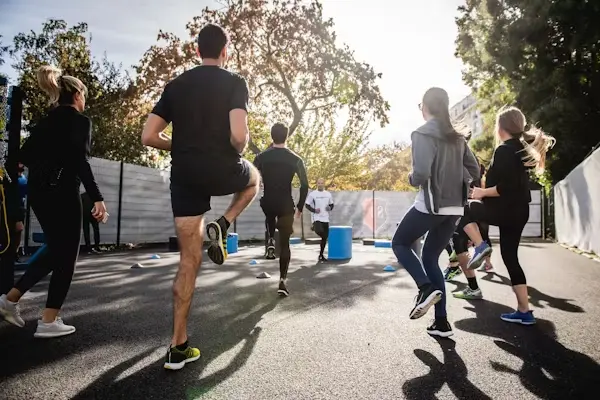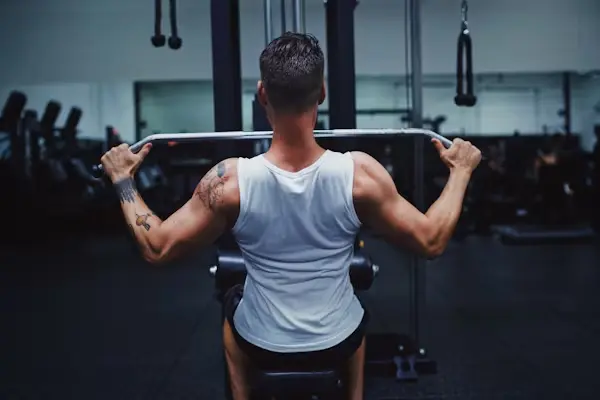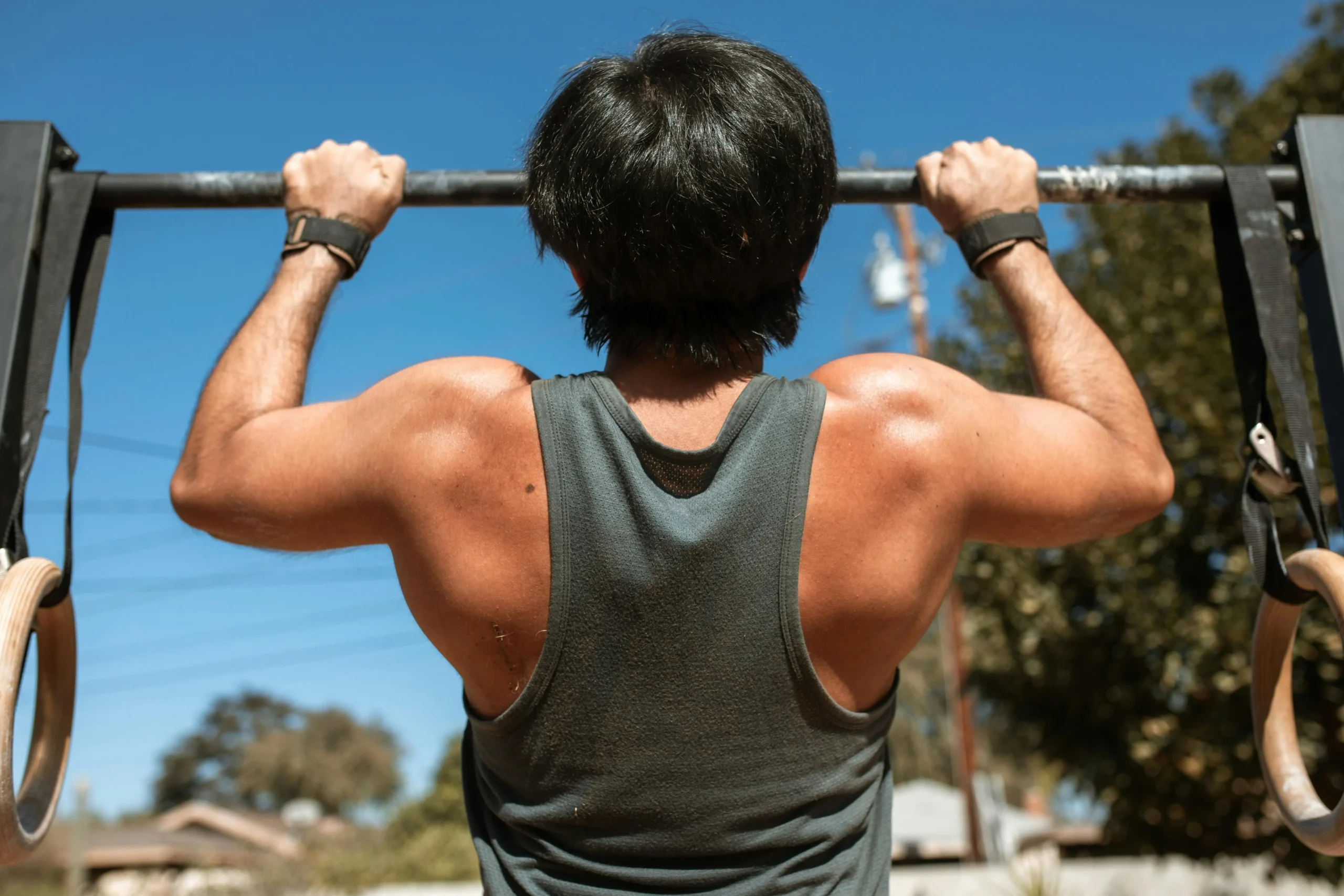Numerous muscles in the back work together to support all of our daily tasks as well as our workout routines. It is not just one enormous, powerful muscle. Additionally, your back muscles are a vital component of your body.
One or two lat exercises won’t cut it for your workout regimen because you can’t ignore any of these muscles or their functions when training your back!
In this post, I’ll outline the several posterior chain target muscles that comprise the back in this in-depth guide to back workout. I’ll also provide you with the finest back-specific exercises and strength training routines to make sure you’re receiving a full workout.
Table of contents
- BACK MUSCLES ANATOMY
- WHY ARE BACK WORKOUTS IMPORTANT?
- BACK-DAY WORKOUT ROUTINE
- WARMING UP
- 7 BEST EXERCISES FOR A BACK DAY WORKOUT
- FREQUENTLY ASKED QUESTIONS
- 1. Why is training all back muscles important, not just the lats?
- 2. What are the key muscle groups in the back, and why are they important?
- 3. Can I just do pull-ups and rows for my back workout?
- 4. How does a strong back contribute to overall health and fitness?
- 5. What is a recommended back-day workout routine?
- 6. How important is warming up before a back workout, and what exercises are recommended?
- 7. Are there alternative exercises for those listed in the routine?
- 8. How often should I train my back for optimal results?
- 9. How can I ensure progress in my back workouts over time?
- 10. What are your final thoughts on mastering back workouts?
- FINAL THOUGHTS
- Latest Posts
BACK MUSCLES ANATOMY

Let’s review muscle anatomy before we get into back-specific exercises and regimens for muscular building. This will help you stay focused as we discuss which back muscle or region we’re targeting with each action.
The largest muscle in the upper body, the back is composed of five key muscle groups that we must work on throughout our training. These are:
- Lats
- Upper and Lower Traps
- Low Back / Erector Spinae
- Rotator Cuff Muscles
- Teres Major
WHY ARE BACK WORKOUTS IMPORTANT?
We shouldn’t assume that lat exercises, such as a few sets of pull-ups or bent-over rows, can sufficiently train the back because it is not just one large torso muscle.
I’ll provide you with some of the best options for back-strengthening exercises as we examine what it takes to acquire a genuinely comprehensive back training regimen.
Reasons to include the back in your training:
- Our body’s back is the most important area for us. Personal activities and all we do in the gym
- The whole strength of the back is not accountable for lats-only focused training, like pullups and rows
- Working the other back muscles, such as the teres major, rotator cuff, and lower back, is important.
- It is essential to build size to train the back in many planes (instead of just vertical pulling) to complete the whole range of motion.
Let’s also understand here why you should train your back and work on building your back muscles? What benefits will you have with this?
- This will enhances your beauty and makes you a true lifter with a big, thick back.
- It improves your posture as your back muscles have an important role for maintaining your proper posture. Your back muscles are the one that keep your shoulders and upper back pulled back instead of rounding forward and help you stand straight.
- Your spine will be more stable. Your back muscles have a crucial role for giving protection to your spine and well-trained back muscles make sure that your spine and torso stays stable and you avoid spine problems.
- If your back is strengthened, your pulling strength will also increase which you will even observe in your workouts such as when doing deadlifts.
BACK-DAY WORKOUT ROUTINE

You will notice and feel the difference if you follow this complete back-to-basics workout, which includes all sets, repetitions, and rest periods in between each exercise.
Here it is the best back workout ever.
| Exercise | Sets | Reps |
|---|---|---|
| Rack Pull (Below Knee Level) | 5 | 3-4 |
| Chin Ups | 4 | 6-8 |
| T Bar Rows | 3 | 8-10 |
| Lat Pulldown | 3 | 8-10 |
| Single Arm Dumbbell Row | 3 | 8-10 |
| Front Barbell Shrugs (3-5 second hold) | 3 | 6-8 |
| Face Pull | 2 | 8-10 |
One way to incorporate science into your strength and conditioning exercises is with his Back Day Workout. You must include science in every session if you want to train like an athlete. With these programs, you may do that and start developing a toned, athletic, and muscular body straight away.

WARMING UP
There’s no reason why warming up for your back day has to be so hard. On the other hand, you can significantly improve your performance with a good warm-up. Before your back workout, do this little exercise.
- Dead Hang: 20 to 30 seconds
- Disassembles in 10 to 15 seconds
- Face Pulls: 10 to 15 seconds
- Lat pulldown with a straight arm: 10–to 15 seconds
- Ten to 15 seconds for a single arm row
- High Row: 10 to 15 seconds
- Rows bent over for 10 to 15 seconds
7 BEST EXERCISES FOR A BACK DAY WORKOUT
1) CHIN-UPS
Though I could have anticipated seeing a pull-up here, I went with a chin-up. I included the lat pulldown in this workout regimen because it is extremely similar to the pull-up, not because I think the chin-up is inherently better (in fact, I think you should alternate between the two).
- Using an underhand, shoulder-width grip, grab a pull-up bar.
- Let your body dangle over the bar.
- Slant your head slightly back and pull your chest up to the bar.
- See yourself bringing the bar down to your chest rather than thinking of raising your body.
- Raise your body till your head clears the bar, then hold the position and gradually descend.
2) RACK PULL
A deadlift and a rack pull are not the same thing. There are similarities, and a deadlift can be executed without a rack. However, the rack pull is a stand-alone workout that targets the latter portion of the deadlift.
- Using an underhand, shoulder-width grip, grab a pull-up bar.
- Let your body dangle over the bar.
- As you retract your scapula, attempt to pull your shoulder blades together.
- Slant your head slightly back and pull your chest up to the bar.
- See yourself bringing the bar down to your chest rather than thinking of raising your body.
- Raise your body till your head clears the bar, then hold the position and gradually descend.
3) T-BAR ROW
While the barbell row is equally effective, I added the T-bar row as well. Our list of the Best Lat Exercises and Workouts includes both. It’s a good idea to switch up these exercises, so when you’re ready to advance your training, think about replacing your t-bar row program with a barbell row.
- With your hands slightly wider than shoulder-width apart, take an overhand grip on the handles of the T-Bar machine as you stand over it.
- With your arms straight at the beginning, pick up the weight in a deadlift fashion. Lean your body forward and slightly push your hips back. Lower yourself until your upper body forms a minimum of a 45-degree angle.
- Drive your elbows up toward the sky while keeping them tucked in to lift the weight while maintaining your shoulders pulled back.
- After bringing the weight up to your chest, gradually release it.

4) LAT PULLDOWN
One of the few pieces of equipment in this workout is the lat pulldown, and there’s a solid reason I went with it. It lets you focus only on your back muscles and lats by stabilizing your lower body.
When doing them, you’ll utilize the regular width and an overhand grip.
- Make sure your knees fit tightly underneath the sitting pad. As you stand up, use an overhand grip on the lat bar that is slightly broader than shoulder-width apart
- Take a seat and prepare yourself.
- Allow the weight to draw your arms up to their maximum length. Every rep starts from this position.
- Pull your shoulders back and incline your chest upward by retracting your scapula.
- Lower your elbows to the ground. Pinch your scapula together as hard as you can.
- When the bar reaches your chest, pull it down. Hold, then gradually raise the bar again.
5) SINGLE-ARM DUMBBELL ROW
An excellent unilateral exercise that requires shoulder extension to row is the single-arm dumbbell row. This exercise has several benefits, including the added benefit of being a wonderful way to uncover muscle imbalances (I adore multi-tasking workouts).
How to do a Single Arm Dumbbell Row:
- Take out your dumbbells and get ready to warm up. Rather than doing them on a flat bench, I like to do them hunched over with my hands supporting me.
- Using your knee or a bench as a strong support, place your hand there. Try to flatten your back by bending over and sticking one leg back.
- Using a neutral grip, pick up the weight and allow it to pull your shoulder downward.
- Pull your elbow up toward the sky while retracting your scapula in a controlled manner.
- Another way to modify the exercise is to do a hip row, in which you drag your elbow down to your hip more like a sweeping motion.
6) FRONT BARBELL SHRUGS
A developed back would not be possible without traps. How often have you encountered guys that appear to be large but lack certain features? Their traps are frequently the missing component.
Since these muscles have a significant effect on your entire body, we will be using barbell front shrugs because of their wider range of motion. Select a weight that will enable you to support the burden for three to five seconds.
How to do Front Barbell Shrugs:
- Assemble a barbell and insert the weight plates of your choice into it. Using an overhand grip and shoulder-width apart, grab the barbell.
- Raise the bar to release its grip and let your shoulders drop forward.
- Shrug and pull your scapula back, attempting to touch your ears to your shoulders.
- Repeat after letting the weight descend smoothly.
7) BACK EXTENSION
The importance of back extension for erector spinae training has previously been touched upon above. You should incorporate this machine exercise into your routine as well.
As you gain experience with this exercise, you can increase its difficulty by holding a weight plate.
- Install a machine for back extensions. The hip pad should be somewhat higher than your hips.
- Lean back in the machine and spread your legs wide. Play your hands behind your head while avoiding contact with your upper arm. Flex and curl down on your back in a controlled manner.
- Lower yourself as far as you can, curl down, and then raise your back up until it is straight.
- After a few seconds, maintain an isometric hold and repeat.
These exercises are just few from the extensive list of awesome back exercises as you can’t do all at once. Apart from these exercises, some other alternative exercises which can work effectively and you can give them a try include face pull, cable reverse fly, bentover back row, chest supported row, meadows row, helms row, seated cable row, kroc row, and pull ups and pull up variations.
FREQUENTLY ASKED QUESTIONS
1. Why is training all back muscles important, not just the lats?
Training all back muscles is crucial because the back consists of multiple muscle groups, including the lats, traps, erector spinae, rotator cuff muscles, and teres major. Each muscle group plays a specific role in supporting daily activities and workout routines. A comprehensive back workout ensures balanced strength and muscle development, improving posture, stability, and overall back health.
2. What are the key muscle groups in the back, and why are they important?
The key muscle groups in the back include the lats, upper and lower traps, low back/erector spinae, rotator cuff muscles, and teres major. These muscles support the spine, aid in movements such as pulling and lifting, and contribute to a strong, stable posture. Training these muscles can prevent injuries, enhance athletic performance, and improve aesthetic appearance.
3. Can I just do pull-ups and rows for my back workout?
While pull-ups and rows are effective exercises for the back, they primarily target the lats. To achieve a well-rounded and comprehensive back workout, it’s important to include exercises that target all the back muscles, such as rack pulls, chin-ups, T-bar rows, lat pulldowns, single-arm dumbbell rows, front barbell shrugs, and back extensions.
4. How does a strong back contribute to overall health and fitness?
A strong back contributes to overall health and fitness by enhancing posture, stabilizing the spine, supporting daily movements, and reducing the risk of back pain and injuries. Strong back muscles also improve performance in various sports and physical activities by enabling more powerful and efficient movements.
5. What is a recommended back-day workout routine?
A recommended back-day workout routine might include exercises like rack pulls, chin-ups, T-bar rows, lat pulldowns, single-arm dumbbell rows, front barbell shrugs, and face pulls. This routine should incorporate sets, reps, and rest periods designed to maximize muscle growth and strength development.
6. How important is warming up before a back workout, and what exercises are recommended?
Warming up before a back workout is crucial to prepare the muscles and joints for the upcoming exercises, reducing the risk of injury and improving performance. Recommended warm-up exercises might include dead hangs, dislocates, face pulls, straight-arm lat pulldowns, single-arm rows, high rows, and bent-over rows, each performed for 10 to 15 seconds or reps.
7. Are there alternative exercises for those listed in the routine?
Yes, there are alternative exercises for those listed in the routine that can also effectively target the back muscles. Alternatives might include face pulls, cable reverse flies, bent-over back rows, chest-supported rows, meadows rows, helms rows, seated cable rows, Kroc rows, and pull-up variations. These alternatives can be used to add variety to your workout or to adapt to available equipment.
8. How often should I train my back for optimal results?
For optimal results, aim to train your back 1-2 times per week, allowing sufficient recovery time between sessions. This frequency ensures that your back muscles receive the necessary stimulus to grow and strengthen while also providing adequate rest to prevent overtraining and facilitate muscle repair and growth.
9. How can I ensure progress in my back workouts over time?
To ensure progress in your back workouts over time, incorporate the principle of progressive overload by gradually increasing the weight, volume (sets and reps), or intensity of your exercises. Additionally, regularly varying your workout routine by incorporating different back exercises can prevent plateaus and continually challenge your muscles. Tracking your workouts and setting clear, achievable goals can also help monitor progress and maintain motivation.
10. What are your final thoughts on mastering back workouts?
Mastering back workouts involves understanding and executing a variety of exercises that target all the major back muscles. It’s important to focus on proper form and technique, especially when performing complex movements like deadlifts. Initial efforts should emphasize learning the correct form with light weights before progressing to heavier loads. Consistency, proper nutrition, and tracking workouts are key to achieving significant improvements in back strength and appearance.
FINAL THOUGHTS
Even though it appears simple, I recall how challenging it was to master the trap bar, sumo, and standard deadlift variations. Commit to mastering the deadlift. If necessary, record yourself using extremely light weights in an empty gym. Learn proper form and technique for a few weeks before you start to worry about progressive overload. You’ll be astounded at how much you progress in just 6-7 weeks if you put in a little upfront investment. To obtain maximum benefit from this article, make sure you are eating slightly more calories than your body requires (i.e., bulking). Keep track of your exercises, and you’ll succeed. Tell me how it turns out.
Latest Posts
Shed Pounds Quickly: Uncover Secret Weight Loss Journey!
Hello, dear friends and readers! I invite you to take a seat, make yourself comfortable, and accompany me on a trip down memory lane. We’re about to embark on a comprehensive journey through the intricate maze that is my weight loss experience, complete with its many peaks and valleys, as well as a few unexpected…
How to Start Calisthenics?
Embarking on the journey of Calisthenics is like rediscovering the power and potential that resides within the simplicity of movement. This ancient form of strength training, rooted in the very essence of human physical capability, offers a path to fitness that is as accessible as it is transformative. In a world cluttered with high-tech gym…
